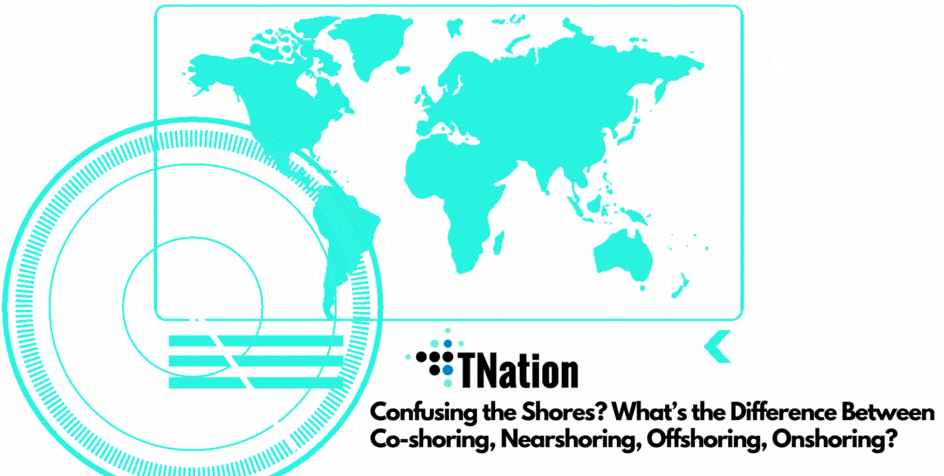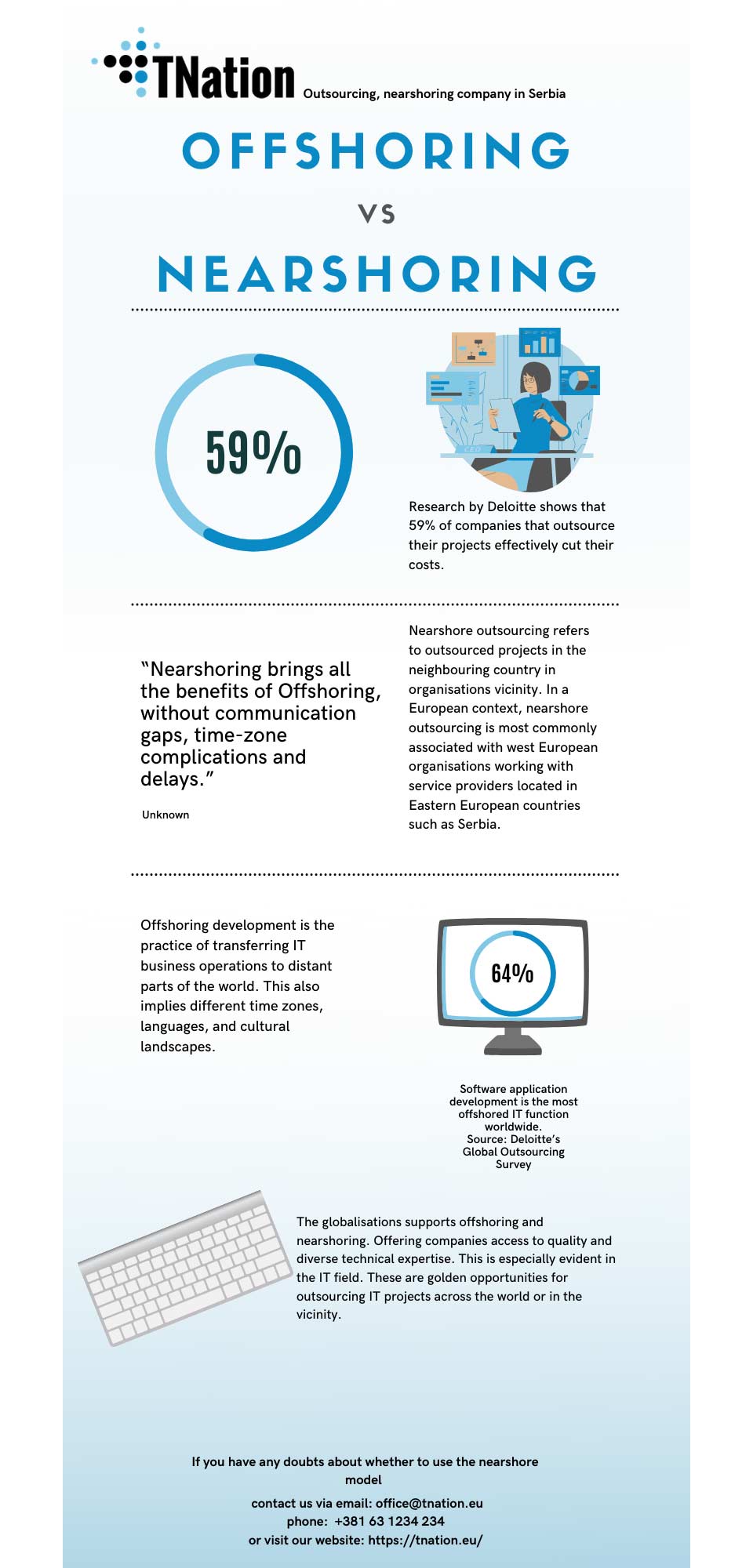TNation, as an IT services company, is very aware that the industry has many perplexing terms. These technical words are often confusing and robust. All this mentioning of shores raises the question: What is the meaning and difference between co-shoring, nearshoring, offshoring and onshoring?
All of which is, more or less, the outsourcing category in a simple explanation. However, the terms define a distinction between the geographical location and not precisely referring to an actual shore. At the very core of their meaning is the expression – sourcing.
Definition of sourcing is an act through which the companies delegate their processes and projects. The sourcing method allows businesses to assign work to external or subsidiary companies anywhere in the world. Its meaning explains the origin of „shoring words“, which means that organisations can relocate or outsource resources in any country in the world.
Outsourcing is contracting a third-party service provider to manage and complete particular work for a specific time, cost, and service level. This sensation of transcending borders has propelled computer programming as the most prominent area. In 2019, Grand View Research estimated the value of the global information technology IT services market at $520.74 billion.
Further fueled by the increasing trends of globalization, the IT outsourcing industry continues to emerge. Today’s modern world, characterized by increased interactions and integrations between countries, translates to more interactions between CVG and IT companies. The concerned organizations, more often, find it necessary to enter into relationships with IT companies and shift some of their activities to other organizations, which are mostly located in different countries.
The CVG directly benefiting from the increased use of the internet, which has opened access to other countries and foreign markets, can link with IT companies abroad. This access provides convenient openings where CVGs can access a diversity of knowledge and a technology-focused workforce from far regions. For instance, the little door access can enable the involved entities to access specialized skills and technology that are rare and hard to find in their home market. Besides, transacting with companies in the foreign market help lower costs as it allows more production around the clock. Ultimately, the mentioned factors make the engaged organizations be able to compete, a factor that strengthens them into international powers.
For example, European IT services have over five million developers, while average hourly rates in Eastern Europe are $32,29. In turn, it creates opportunities for organisations to produce and satisfy customers’ needs while reducing expenses. Outsourcing at its early beginnings was an operation of cutting costs. However, globalism created a highly competitive IT industry market. At the centre of it is outsourcing as a mainstream management practice.
Offshoring
Offshoring is an international work distribution to an independent service provider in another country. Offshoring is growing fast as an essential part of the world economy. Companies worldwide are striving to reduce costs and improve productivity level. Hence, the organisations turn to shift aspects of their operations to overseas service providers to remain competitive on the market.
Decision-making to offshore projects depends mainly on wages, cost efficiency, immense talent pool, language proficiency, infrastructure and high code quality. Ever-increasing competition in the globalised market is what drives offshoring in every economy in the world. In Germany, offshoring gains its momentum, and numerous organisations are already involving in offshoring initiatives. IT activities are emerging as the fast-growing sector, and projects are relocating to eastern European countries, China, and India as the preferred locations.
While outsourcing and offshoring have similar definitions, they are different in the sense of job transfer. If an organisation is relocating to a centre in their ownership, it refers to a captive service delivery model. In the second case of third party offshoring, the definition refers to an offshore outsourcing service delivery model.
Two distinct models show that outsourcing and offshoring are similar only in giving the job to an external company. And while outsourcing does not have a specific location, offshoring is predominantly oriented toward other countries. Based on the country’s location, offshoring separates into two subdivisions: nearshoring, farshoring and onshoring.
Nearshoring
Nearshoring is, by definition, the relocation of company activities to a neighboring country. In other words, nearshoring is similar to offshoring with a variation in the location. In nearshoring, IT services target nearby countries geographically and culturally. Industry trends show that western Europe is more likely to partner with IT companies from central and eastern Europe.
Farshoring
Farshoring is a sourcing service that transfers work in countries with lower operating costs and distant lands. Businesses looking for the best price for the service decide to source their software development projects to faraway countries. Industry experts question the practicality of farshoring. In truth, far countries are in different time zones and distinct cultures. According to them, it causes a misunderstanding between the organisation and the service provider.
Onshoring
Onshoring is dissimilar to offshoring, namely because of the location. Onshoring is an outsourcing model that transfers activities to a supplier within the homeland. This model is not widespread for cost-efficiency but convenience. Since the organisation is hiring an IT service provider from a different city, the work transfer is similar to hiring a contractor. The global market changes. When costs outweigh the offshoring benefits, some firms shift their projects back to the domestic marketplace for purely economic reasons.
Co-shoring
Co-shoring is an emerging term in the outsourcing of IT services, representing a model that blends the advantages of both onshore and offshore sourcing. By definition, co-shoring is a model of outsourcing, which advocates the partnership between offshore and onshore development teams. Essentially, co-shoring is a type of outsourcing that promotes a collaborative partnership between offshore and onshore development teams. In co-shoring, teams from both the client’s firm and the service provider’s firm work in conjunction on the same IT projects. This model is designed to maximize the strengths of each team, leveraging diverse expertise and resources to enhance project outcomes, embodying the principles of co-shoring through shared responsibilities and integrated efforts.
Co-shoring, Nearshoring, Offshoring, Onshoring – Which one to Choose?
In brief, it depends on the business needs, priorities and objectives. You are navigating your choice between co-shoring, nearshoring, offshoring or onshoring, not only in the direction of „the shore.“ Each of them has different benefits and disadvantages that need to align with your business.
- Co-shoring is choosing the best from all worlds with greater control over the project and remote development team.
- Nearshoring offers proximity to a country next door.
- Offshoring offers the most budget reduction method.
- Onshoring is partnering with a firm in the domestic market.
The decision to choose a specific business strategy depends heavily on the business’s expectations and its operational needs. It involves a process of careful consideration and selection, akin to deciding which store to visit for purchasing goods. Businesses must weigh various factors such as cost reductions, proximity to resources, and the overall balance of benefits. Do they prioritize lower prices, the convenience of nearby services, or strive for a harmonious mix of both? Each choice represents a strategic decision that can significantly influence the business’s efficiency and success in the long term.
Digital transformation and innovation play an essential factor in the growth of many businesses around the globe. According to Statista’s market and consumer data, spending on IT services amount to $1.1 trillion worldwide in 2021. Based on global market research, there is an annual growth of 9% in the number of organisations that decide to implement software. Those who do the leap of faith develop more rapidly than the ones who do not.
If you have any doubts about choosing an outsourcing company for IT services, contact us here. TNation is a reliable IT outsourcing partner in Serbia.

